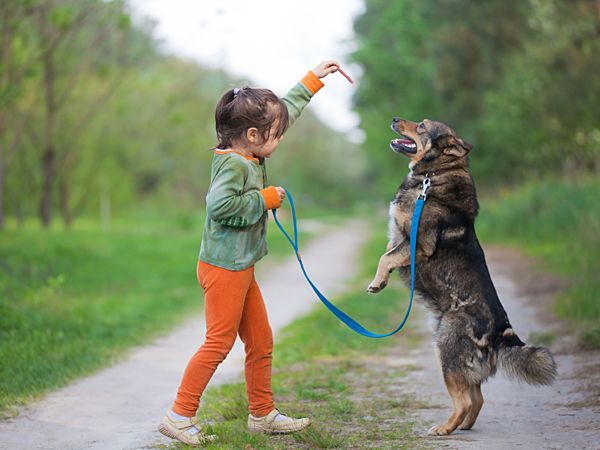Positive Reinforcement vs. Traditional Training: Which Works Best?
Understanding Dog Behavior Around Children
Introducing a dog to a household with children can be a rewarding but delicate process. Dogs and kids can form deep, lasting bonds, but proper training and socialization are essential to ensuring a safe and harmonious relationship. Whether adopting a new dog or helping an existing pet adjust to a growing family, a structured approach is necessary.
Dogs naturally react to their environment based on past experiences, instincts, and training. Some dogs may be excited and playful around children, while others may feel anxious or fearful. Recognizing canine body language is crucial in preventing conflicts. A wagging tail, relaxed posture, and soft eyes indicate comfort, whereas stiff movements, growling, or avoiding eye contact suggest discomfort. Teaching children how to respect a dog’s space and interpret its signals is just as important as training the dog itself.
Socialization is the foundation of a well-adjusted dog. Exposing a puppy or an adult dog to children in a controlled, positive manner helps them associate kids with good experiences. Start by allowing the dog to observe children from a safe distance, rewarding calm behavior with treats and praise. Gradually introduce closer interactions, ensuring they remain positive. This approach prevents fear-based reactions and fosters a trusting relationship. If a dog has never been around children, short, supervised meetings with well-behaved kids can help. These initial encounters should be brief and stress-free. Avoid overwhelming the dog with loud noises or sudden movements, as this can create negative associations. Instead, encourage gentle petting and quiet interactions, rewarding both the dog and the child for calm behavior.
Speak With A Dog
Training Expert
Speak With A Dog Training Expert
Thank you for contacting us!
We will contact you shortly!
Please try again later.
Winter Protection: Keeping Your Dog Comfortable Outdoors
Winter brings chilly temperatures, icy sidewalks, and shorter days, posing unique challenges for our furry friends. While some dogs love playing in the cold, others may struggle with the cold, especially if you live in an area with ice and harsh weather conditions. As responsible dog owners, it’s essential to know how to keep our pets safe, warm, and healthy during the colder months.
When temperatures drop, your dog’s fur may not always be enough to keep them warm. Small breeds, short-haired dogs, puppies, and senior dogs are especially vulnerable to cold weather. Investing in proper winter gear can make outdoor walks safer and more enjoyable. Dog coats and sweaters act as an insulating layer, helping your dog retain body heat. Choose a coat that covers their neck and belly and fits snugly without restricting movement.
Speak With A Dog
Training Expert
Speak With A Dog Training Expert
Thank you for contacting us!
We will contact you shortly!
Please try again later.
Paw protection is equally important. If applicable to your area, sidewalk salt, de-icing chemicals, and sharp ice can damage your dog’s sensitive paw pads. Dog booties provide an excellent protective barrier, but not all dogs will tolerate them. If your dog refuses to wear booties, apply a pet-safe paw balm before walks to protect their pads from cracking and irritation. After every outing, wipe your dog's paws with a warm, damp cloth to remove salt, ice, and chemicals. Monitoring your dog’s outdoor time is crucial. In freezing temperatures, limit walks to shorter durations and watch for signs of discomfort like shivering, paw lifting, or slowing down. Dogs can also suffer from hypothermia and frostbite, so always pay attention to their behavior in the cold. By outfitting your dog with proper gear and caring for their paws, you can ensure safe and enjoyable winter adventures.


Indoor Comfort and Nutrition: Supporting Your Dog’s Health in Winter
Winter isn’t just about outdoor safety–indoor care is equally important. Just like us, dogs appreciate a warm and cozy space when temperatures plummet. Provide your dog with a comfortable bed in a draft-free area. An elevated or insulated bed can help keep them off cold floors, while extra blankets offer additional warmth. Be mindful of space heaters, as dogs may accidentally knock them over or get too close and burn themselves.
Your dog’s diet and hydration may also need adjustments in winter. If your dog is active outdoors, they might burn extra calories to stay warm, so a slight increase in their food intake could be beneficial. On the other hand, dogs that spend most of their time indoors may require careful monitoring to avoid winter weight gain.
Setting Boundaries Through Basic Obedience Dog Training
A well-trained dog is easier to manage around children. Basic commands such as “sit,” “stay,” “leave it,” and “gentle” help reinforce appropriate behavior. Teaching a dog to stay calm in the presence of excited children prevents accidents like jumping or rough play. Consistency is key in obedience training. Practice commands in various situations, gradually increasing distractions. For example, have children play nearby while the dog practices staying calm. Reward obedience with treats, praise, or playtime, reinforcing good behavior. If a dog exhibits undesirable behavior, redirect its attention rather than punishing it, as positive reinforcement leads to better learning.
Not all dogs instinctively know how to behave around kids. Some may be too energetic, while others may be nervous. Training a dog to be gentle involves exposure and controlled interactions. If a dog tends to jump when excited, teaching an alternative behavior like sitting for attention helps prevent accidental knocks or scratches. Desensitization is also beneficial. Since children can be unpredictable, exposing a dog to common kid behaviors—such as sudden movements, loud sounds, or playful gestures—helps them learn to stay calm. Use gradual exposure, starting with small noises and slow movements before progressing to more active play. Reward the dog for remaining relaxed, reinforcing their confidence around children.
A well-adjusted relationship requires boundaries for both the dog and the children. Dogs should have a designated safe space, such as a crate or a quiet corner, where they can retreat when they feel overwhelmed. Teaching children to respect this space prevents unwanted stress and potential negative reactions from the dog. Similarly, children must learn how to interact appropriately with dogs. They should avoid pulling ears or tails, climbing on the dog, or disturbing it while it eats or sleeps. Educating kids about canine body language and respect helps prevent misunderstandings and builds a strong, positive relationship.
Even the most well-trained dog should never be left unsupervised with young children. Accidents can happen, and supervision ensures safety for both parties. Observing interactions allows caregivers to intervene if needed and reinforce positive behaviors. Training a dog to adjust to kids is an ongoing process that requires patience and consistency. Regular reinforcement of good behavior, combined with proper socialization and clear boundaries, helps create a safe and loving environment where both the dog and children can thrive. By following these steps, families can foster a strong, trusting bond between their pets and their little ones.
Always consult your veterinarian before making significant changes to your dog's diet. Hydration is equally important during winter. Cold weather can be deceptively dehydrating, and outdoor water sources may freeze. Make sure your dog always has access to fresh, unfrozen water indoors and outdoors. Additionally, avoid letting your dog eat snow, as it may contain harmful chemicals or pollutants.
Lastly, keep your dog mentally stimulated indoors on extremely cold days. Interactive toys, puzzle feeders, or indoor playtime can prevent boredom and keep your dog active. By combining a warm indoor environment with proper nutrition and hydration, you’ll ensure your dog stays happy and healthy all winter long. Winter can be a wonderful season for both you and your dog, filled with snowy adventures and cozy cuddle sessions. With the right precautions, you can protect your dog from the harsh effects of cold weather, ensuring they remain safe, comfortable, and happy throughout the season. Whether it's investing in warm winter gear, protecting their paws, or creating a cozy indoor space, every effort counts! Stay warm, stay safe, and enjoy the winter with your furry companions!
